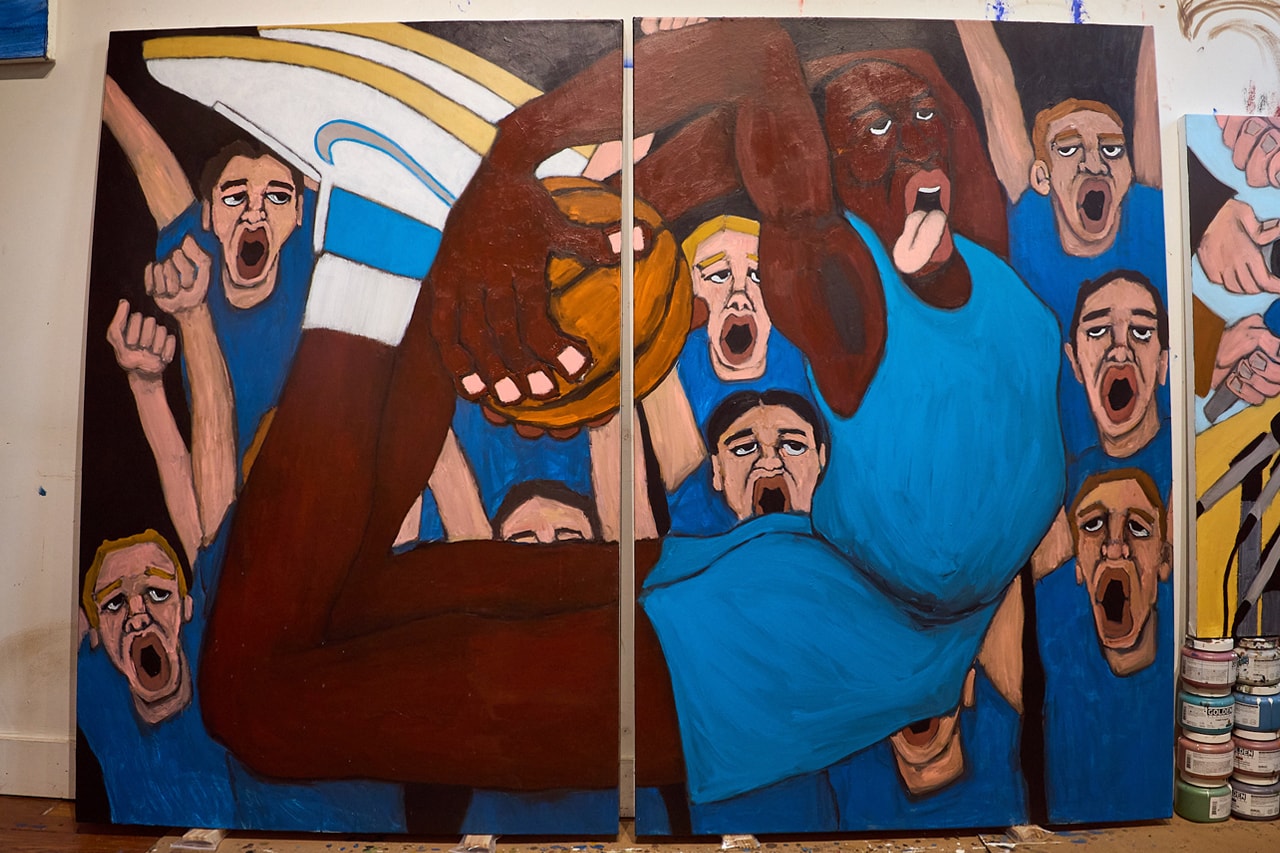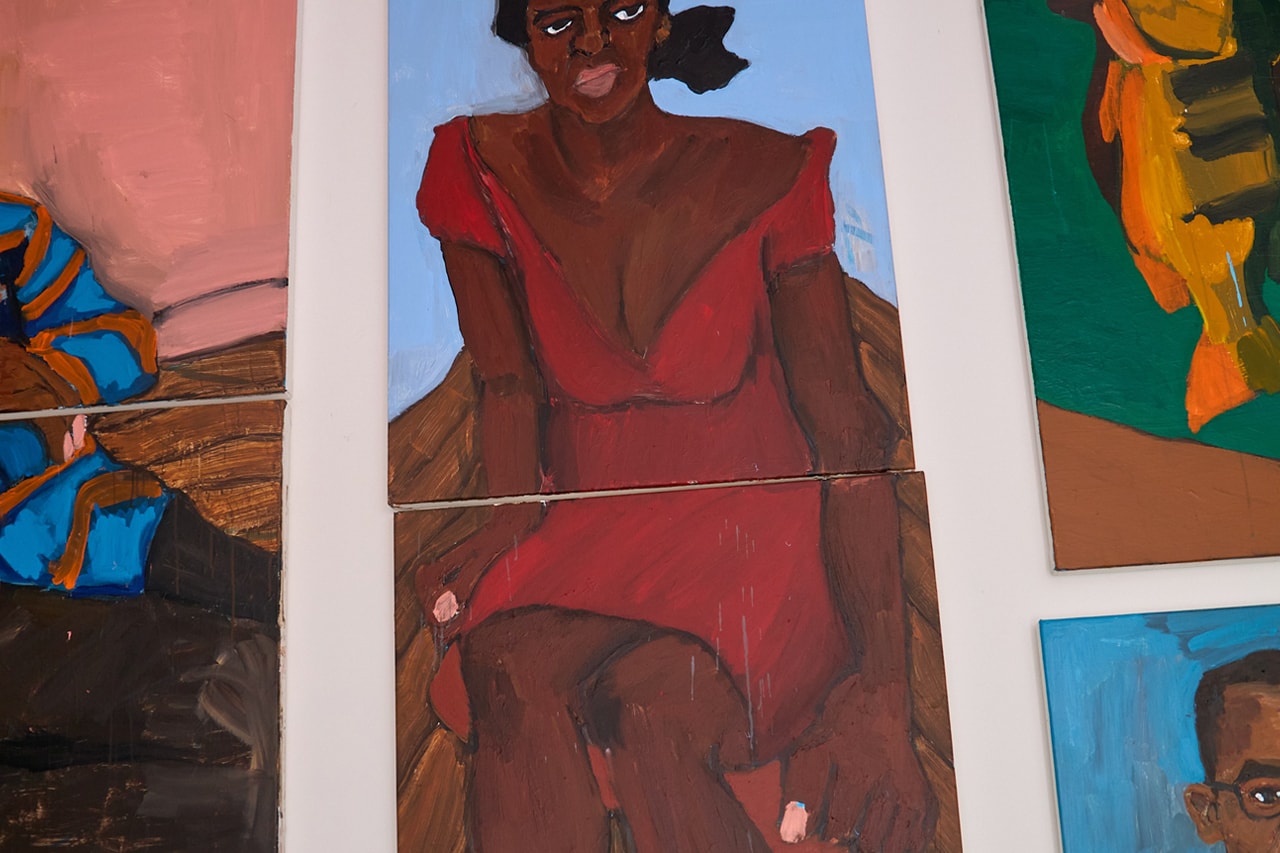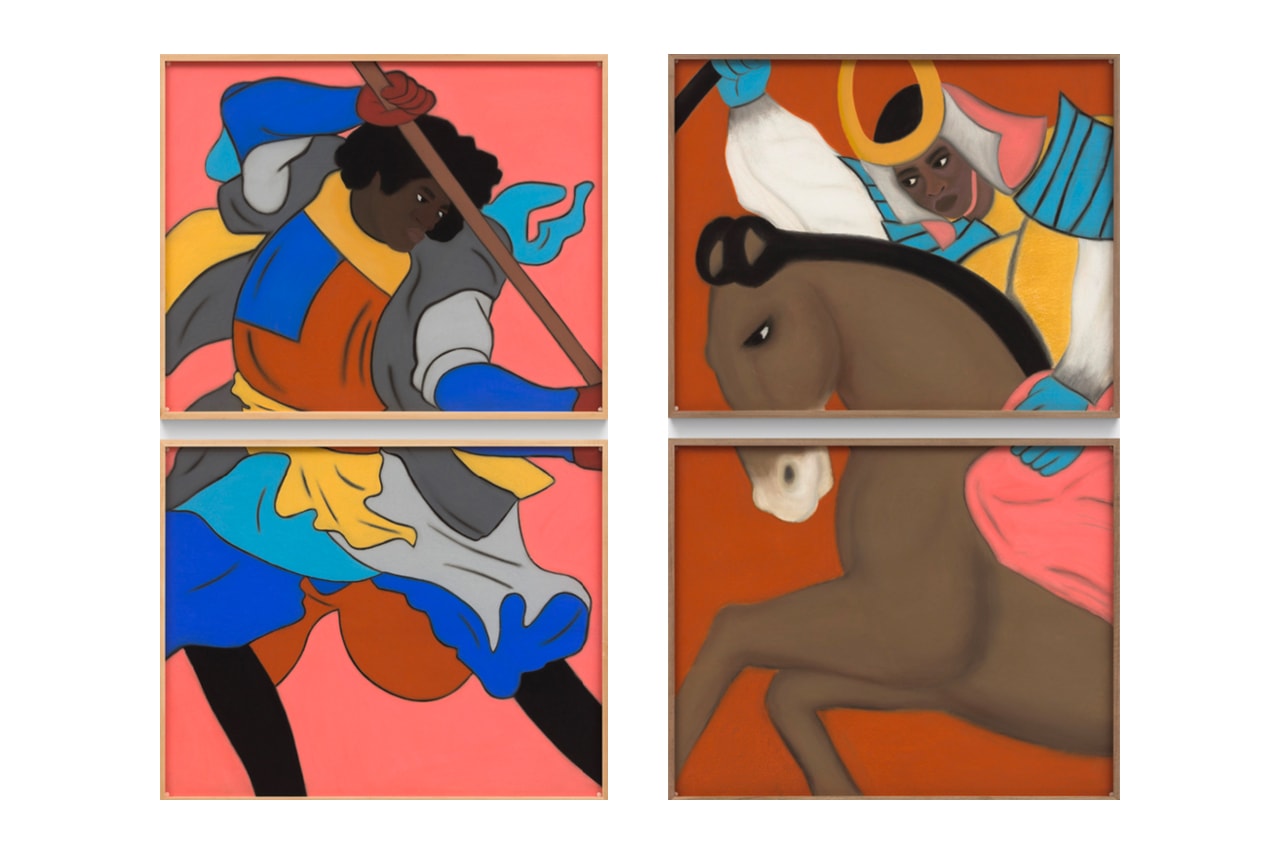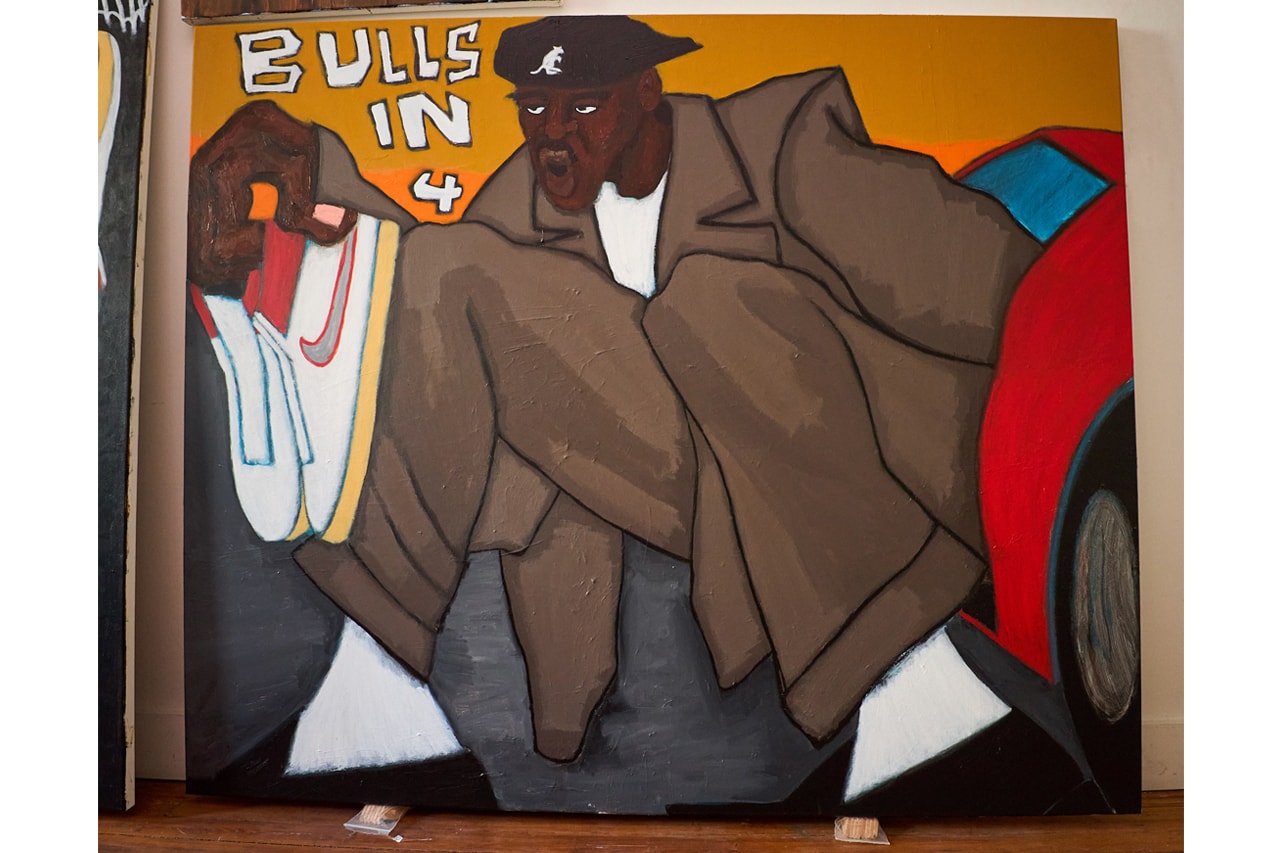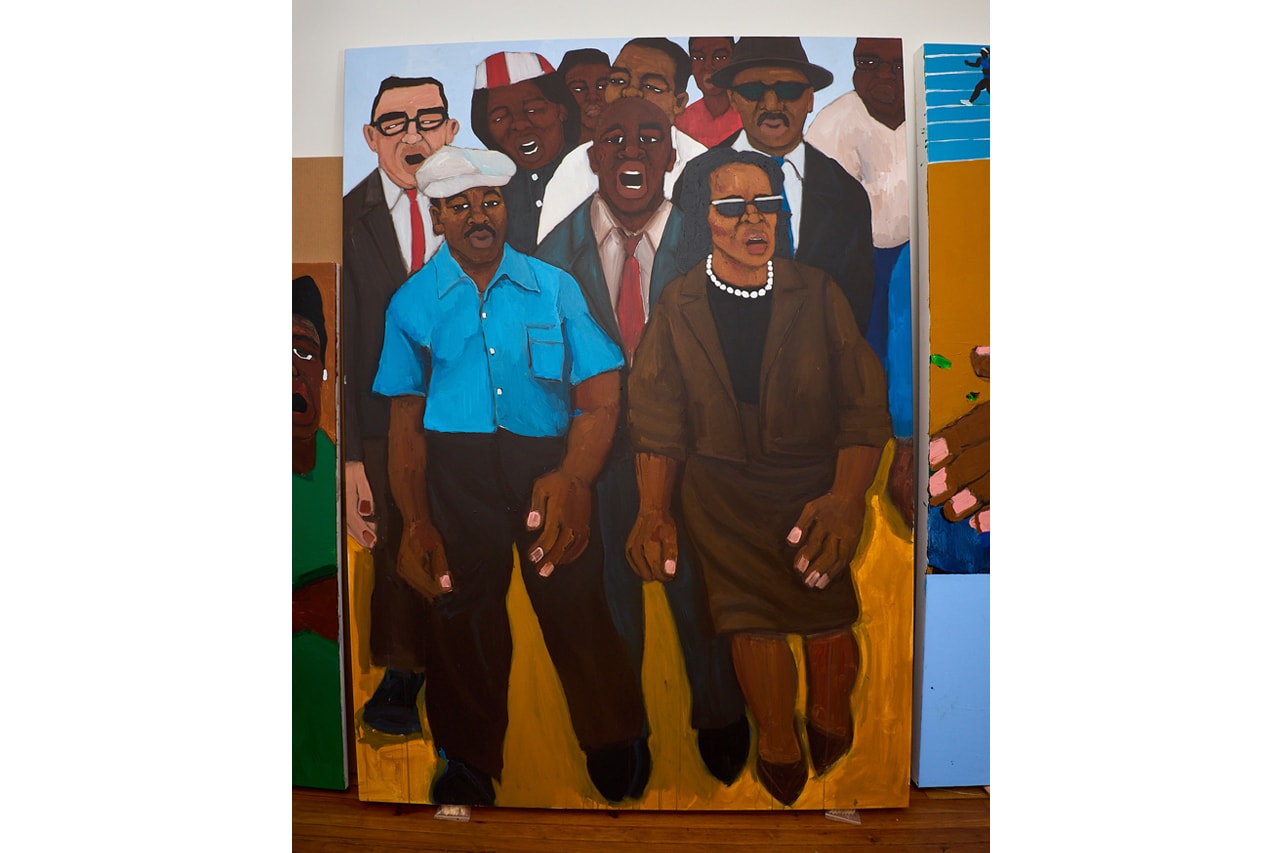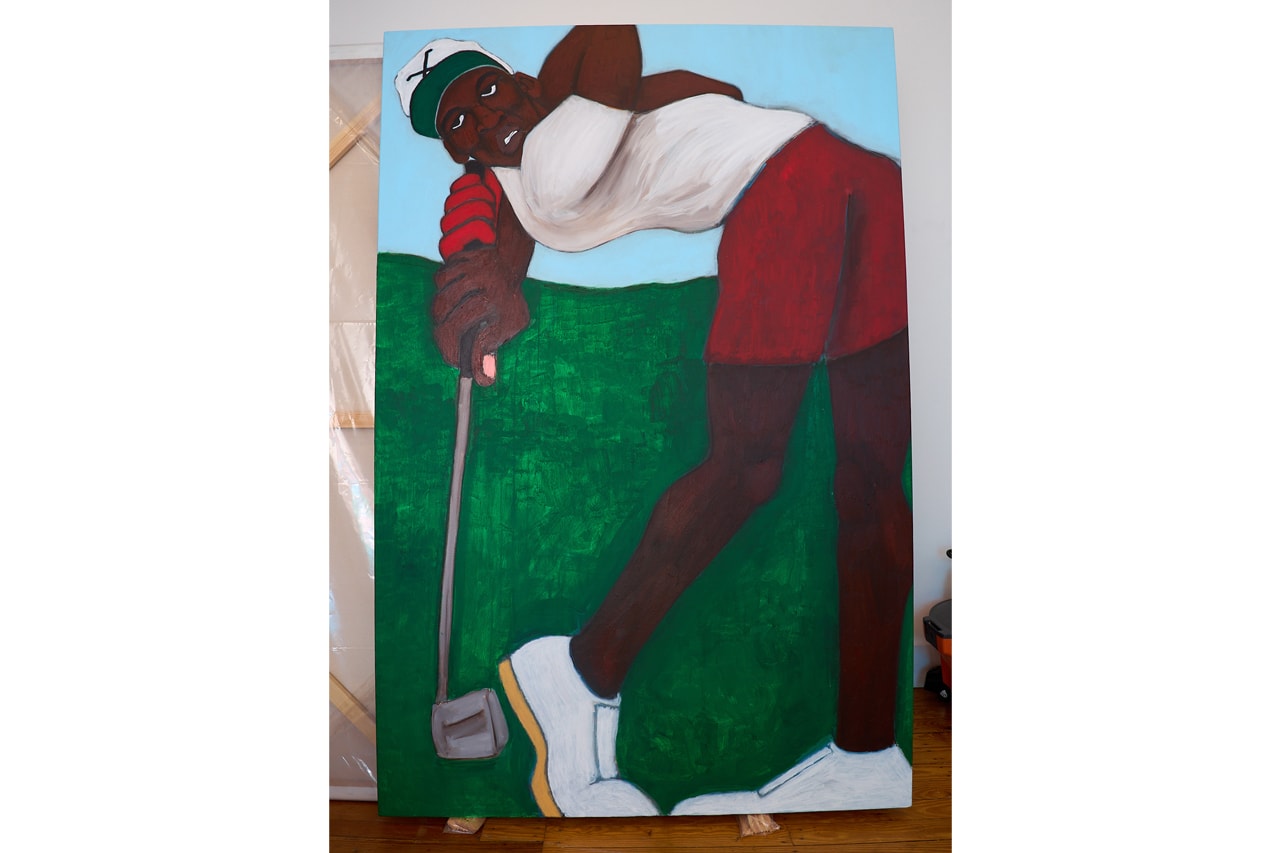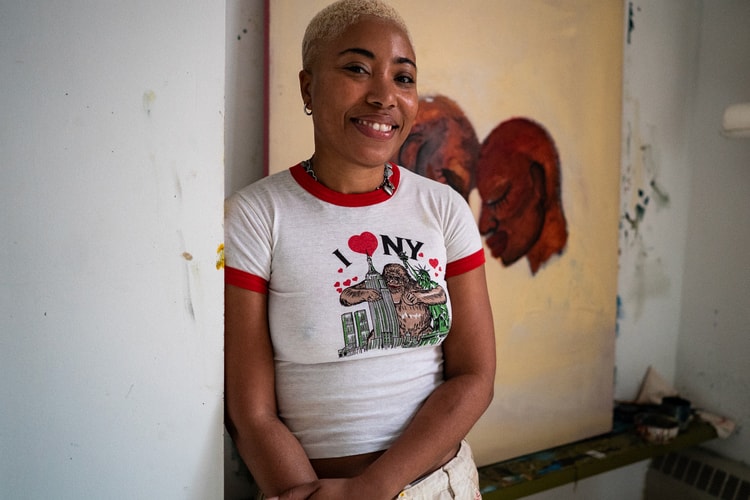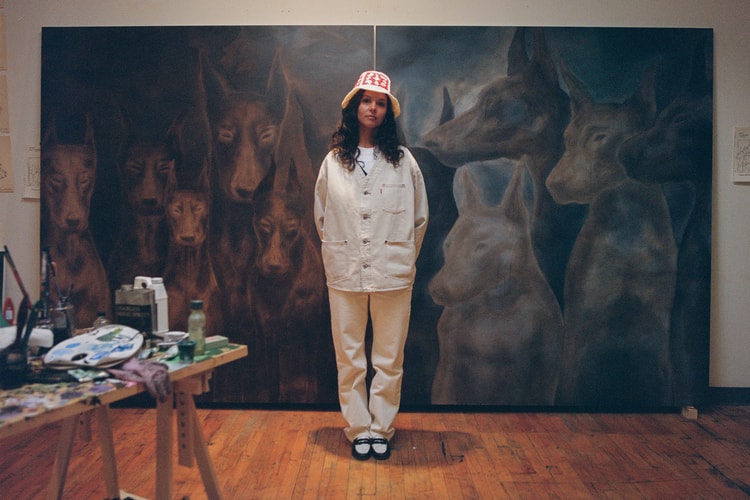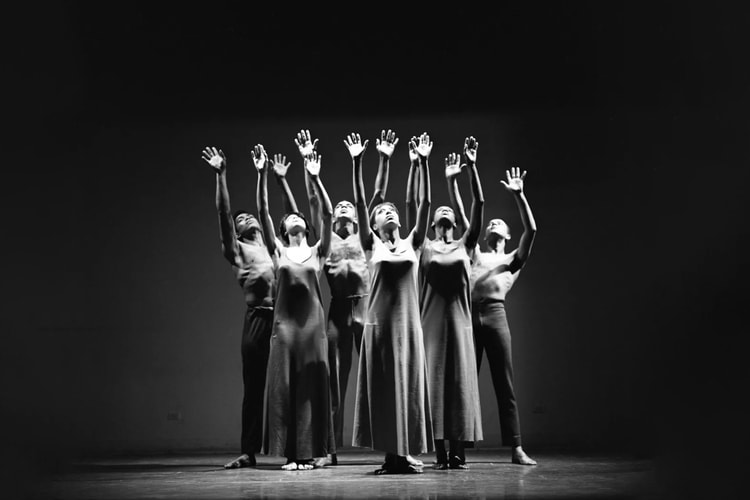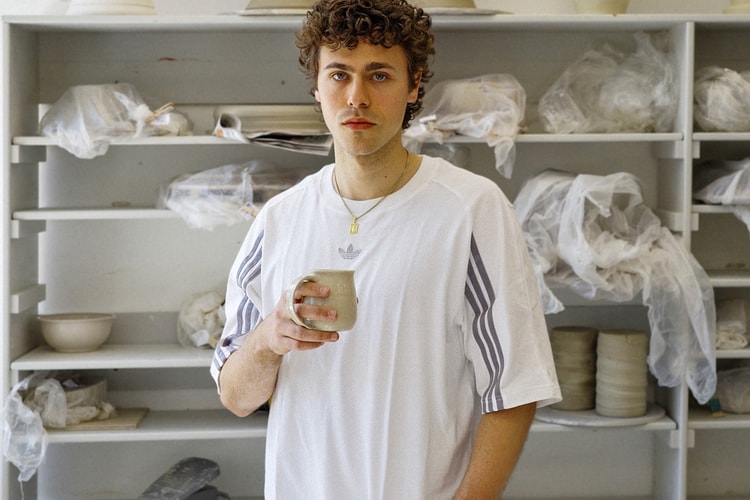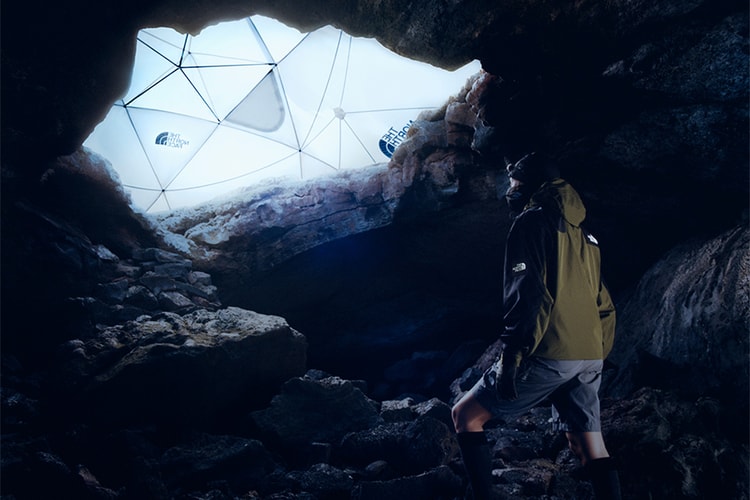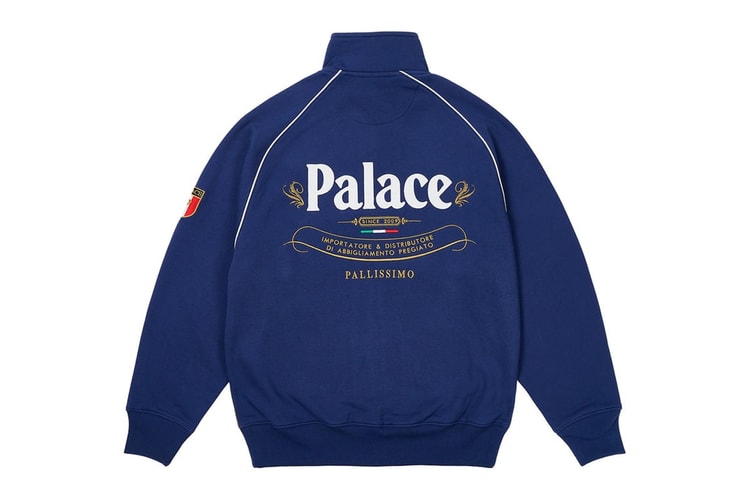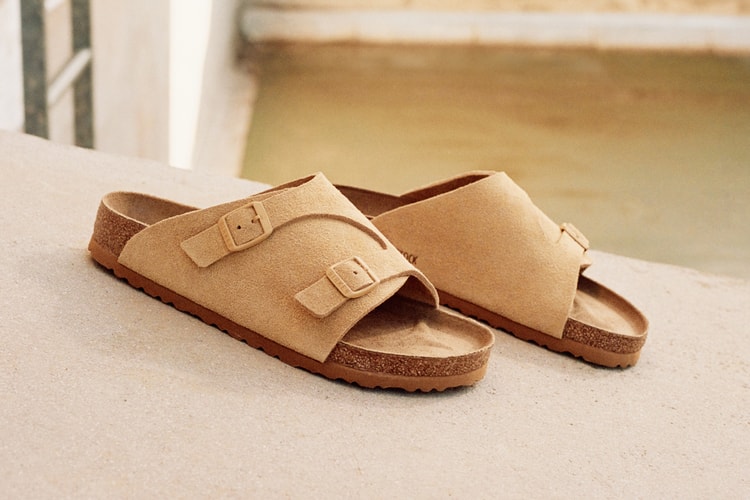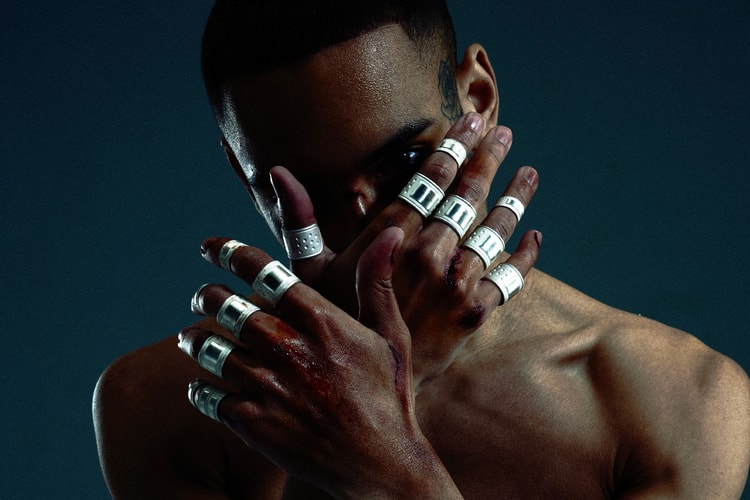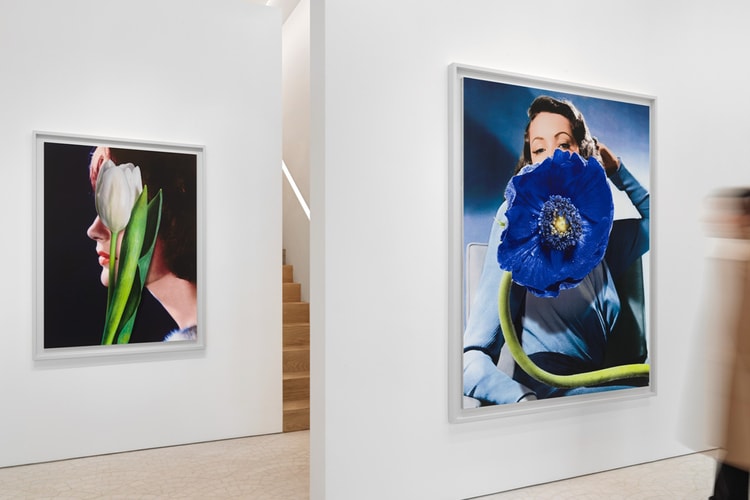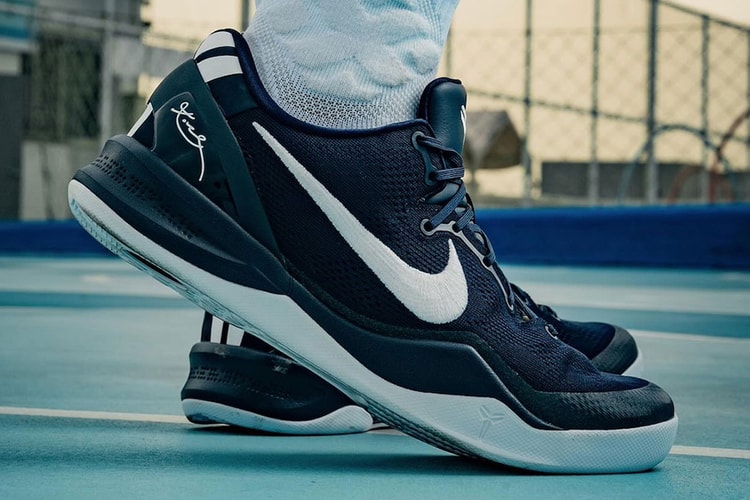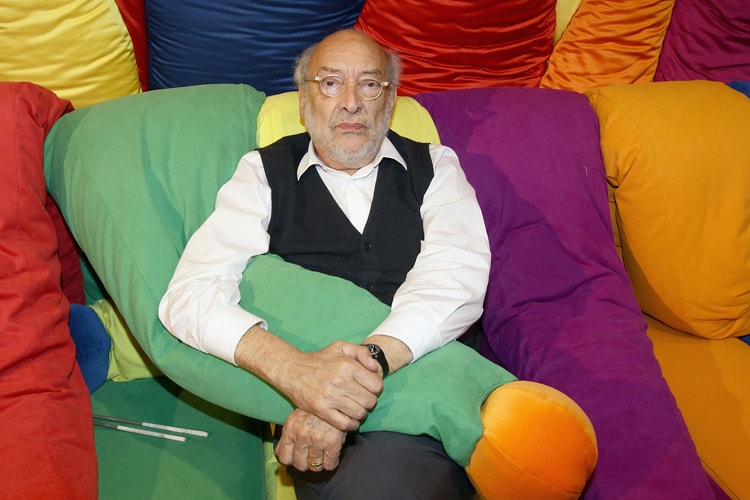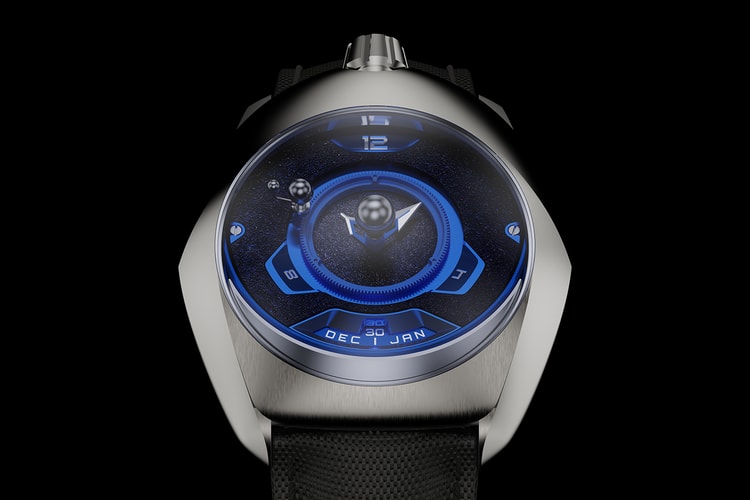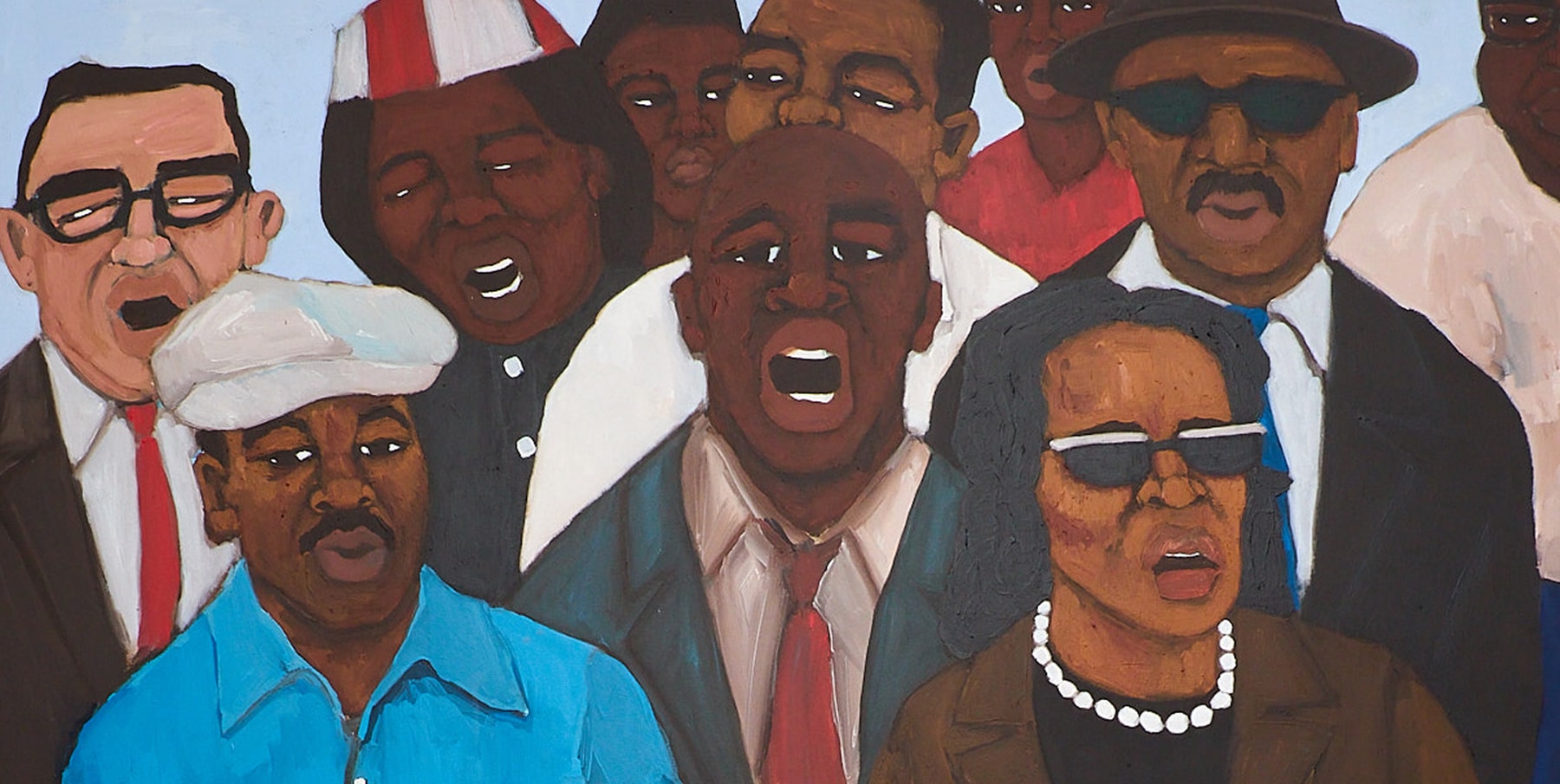

Acupuncture, American football and art are rarely used in the same sentence, but the taxing work ethic needed to excel in each trade has consistently informed the figurative works of Alvin Armstrong. The Brooklyn-based artist is known for creating large gestural paintings that depict influential Black historical figures, from Angela Davis to Michael Jordan, as well as his own interpretive Black experience.
At 42, Armstrong’s journey is a testament to the idea that it’s never too late to follow your passions. Entirely self-taught, his journey has been far from linear: born in a military family, he’s always carried an intense work ethic that was shaped through his years playing sports, along with his service in the Coast Guard and subsequent training as an acupuncturist in New York. The fact that he stumbled into art happened by chance. “I had little capacity for museums and galleries,” he tells Hypeart. “I had no connection to art at all.” Armstrong taught himself to paint only after a reluctant visit to the Brooklyn Museum, where suddenly, his proclivity to use art as a form of personal expression started to fill the void he felt in his medical practice and journey with sobriety.
A simple watercolor set he got gifted quickly turned into 16 hour sessions where he taught himself the foundations of painting. “You really have to do a bunch of things at once to excel,” he recalls when comparing art with acupuncture — “from using your hands, the doctor-patient rapport to even learning a little Chinese. I feel like art is similar. Just putting in the work isn’t enough.”
In just under a six year span, Armstrong has experienced a meteoric rise in the art world, exhibiting a solo show at Chicago’s Anthony Gallery and representation with Anna Zorina Gallery during the 2022 Armory Show, as well as collaborations with Awake NY and a recent print release. For the latest Hypeart Visits, we spoke with Armstrong to understand how he pivoted into the prolific painter he is today and how he uses his practice to spotlight “the beauty and magic of Black people in America and across the world.”
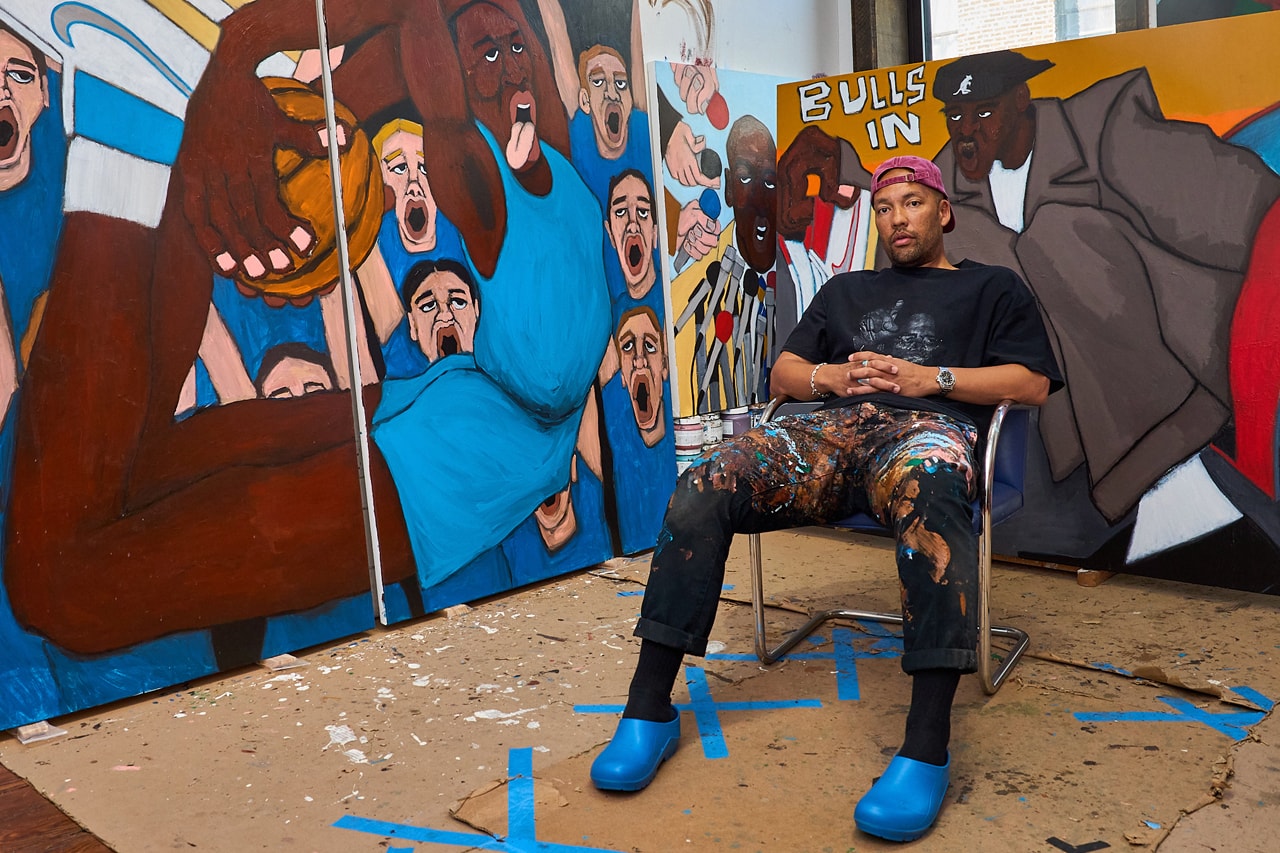
“There’s space. There’s room. There’s something there for me to discover.”
Can you talk about your biggest inspirations growing up and how they have influenced the artist you’ve become today?
I’ve been painting for about five-and-a-half years in total and what happened at the start was I just graduated acupuncture school. Before I started working on people, I wanted to clean up my act: I decided to get sober. In that transition, so much was changing in my life. I just started trying new things as suggested by my sober community.
Once I found museums and visual arts and made the decision to put my all into it, what I drew from was my life experiences in sports. Discipline, work ethic, I knew that I could match the intensity of preparation as anyone else, because there’s only a limited time in each day. That was a measuring stick that I could show up every day and put in as much time as anyone else on Earth. That type of energy is how I got the engine going and still to this day, use to power forward.
Which sports in particular?
Football was my main sport. My family, however, is big on basketball. My dad played collegiate ball, my sister played point guard in high school, my brother played at Columbia here in New York, my nephew’s dad also played in the NBA.
I played volleyball and soccer, but I really could never choose one. I always played many different sports — it really was about that competition. As a kid, I enjoyed the fact that it was the closest thing to a meritocracy that I had discovered. The fact that the hardest working, most dedicated usually ended up on top. So I was really drawn to the competitive sides to all sports. Football was the main one though.
Are there particular players you revered as idols? On-and-off the field/court?
I’m almost 42, what I draw most from watching sports today is the stories and advice these players are giving. I would probably say Kobe Bryant is probably the most influential in terms of what he has said and what I can pull from daily in how he approached his craft. Michael Jordan as well with The Last Dance. Growing up, my dad was from Crenshaw, LA — he’s no longer here with us, but he was a huge Magic Johnson fan. So our home was a huge Lakers house. That being said, I was still heavily influenced by Jordan’s level of preparation, style and grace.
Present day, getting a peek into what LeBron and Tiger Woods do to prepare. Tons of women: Mia Hamm was a huge influence on me as a young kid. Cheryl Miller, I mean are you kidding me? These people that are insane and delusional in their approach and what that can turn into — a life of dedication.
The 180 from acupuncture and medicine to full-time artist is interesting. Can you talk about that transition?
When I got settled in New York, I decided to enroll in an intensive four-year acupuncture program. Halfway through, I asked myself: “Do I really see myself as a clinician?” I loved the medicine and knew what it did for me. But I started to question the type of lifestyle I wanted going forward. At the end of school, I took the board and got licensed, but still found myself at a crossroads.
Once I started being honest with myself, and what it would mean to put my all into medicine, the first thing I wanted to do was sweeten my side of the deal. Up until that point, I was work hard, play hard. That process of changing life habits was so intense and there was so much change happening in my life. Before that point, I had little capacity for museums and galleries. I had no connection to art at all. I tried with friends who were into it. But for whatever reason, I didn’t have the capacity to take anything in. Once I got sober, I had a lot of free time on my hands. Things started slowing down in my life and I was trying all types of different things. I was knitting hats, whatever I could to fill the space. Through the suggestion of a friend, I finally started going to museums and something just clicked to where I was drawn to what I was looking at. It was just simple landscape watercolors at the Brooklyn Museum.
My friend suggested: “Maybe you should paint.” She bought me watercolor brushes the next day and they sat in my room for three months. I eventually picked up those brushes and once I got into painting, I learned so much so fast. 16 hours a day for the first three years. I wasn’t doing it for a job, I was just drawn to learning. I’ve always been a sponge and there was so much available online. It paralleled in many ways to how dynamic the acupuncture program and medicine is. You really have to do a bunch of things at once to excel — from using your hands, the doctor-patient rapport to even learning a little Chinese. I feel like art is similar. Just putting in the work isn’t enough.
What draws me to visual arts is how vast it is and there’s room for us all. I’m an intense person, an obsessive type and I can just go as deep and intense as I want to in any direction. There’s space. There’s room. There’s something there for me to discover.
“I want to showcase the magic of Black people, but connect to everyone.”
Do you find your military background seeping its way back into your art?
I was a Navy brat. My dad was very inense. I was intense my whole life and the military was kind of slow pace, compared to how I operated as a human. I don’t really give them credit, in terms of my organization or my dedication — that was already there in me. I felt like the military and Coast Guard was a means to an end. [laughs] I couldn’t wait for it to be finished. I met a couple of people that I’m still friends with, but the service was actually disappointing in what it ended up being for me.
How would you define your practice?
I look at it in just that way: a practice.
I’m extremely consistent in coming in here and working every day. My ethos is to move through and let go. What’s most important to me is that I safeguard my freedom to really push myself and to explore and grow as an artist, as a human. I’m learning how to give myself grace these days and more balance within.
The paintings, this work and the bigger goal for me, they already provide me with the access into rooms with people that I would have never had the opportunity to get close to. At the end of the day, my hopes are to get in contact with people that are inspiring and that I want to have conversations with; to explore and collaborate on way bigger ideas around community and helping others.
In the past, you’ve stated that your art is a way to comment on how society fetishizes Black people as a means for entertainment. Can you expand further on that thought?
My thoughts are always changing, but I definitely still agree with it and feel strongly about what I’ve said in the past.
However, my work is a love letter to humanity at large, offering a fresh lens into the beauty and magic of Black people in America and across the world. As I go deeper into the daily practices of being an artist, I want to showcase the magic of Black people, but connect to everyone. Sometimes, things happen and are difficult and I want to be honest and touch on those subjects. But I don’t want to limit myself to just trauma or negativity.
What is your ideation from start to finish?
I’m not much of a drawer. I like to get straight to the canvas, using paint to inform a simple underpainting. I like to get basic shapes down. Nowadays, I’m figuring out how the fingers are bending and so forth — so pulling away from looking at a reference point at all when I’m painting. It’s been really liberating. There’s a lot of mental prep that goes on before, but once I get going, I just figure it out as I go along.
I have friends who draw, then make a small painting, then another, then a larger one. So by the end, they know exactly what they want to do. I’m the complete opposite: I like to figure it out as I go. What makes a painting special, for me at least, is a lot of those instinctual, improvised moments within the doing process. I don’t sit working on a single painting for longer than 10 or so days. If I lag too long, the idea will stiffen.
You magnify your subjects largely on a single color background. Can you talk about your aesthetic choices when it comes to composition?
I’ve never taken a color theory class. The large paintings take about 25 to 30 hours each, at least. It’s about feeling for me, so when I’m spending so much time on a given work, I like to make the figure as large as possible within the frame of the painting, just to evoke more drama and expression. I want people to look at the work and have some type of emotion.
For the longest time, I was so focused on making sure my proportions were legitimate and then at a certain point, I got really comfortable with letting go. That bled into my aesthetic choices, where now the hands of my figures are bigger and the marks feel like an abstract painter. I’m not overthinking it anymore. It’s in my gut, a familiar place.
“This isn’t a game. It’s not just about me.”
Henry Taylor is also a big inspiration. Can you talk about how you imbue art historical references in your work?
Henry is probably the most impactful person in the art world for me. My father’s from LA and Henry’s also from the area. There’s so many overlaps. It’s more about his work ethic, though, from his energy and what he does, which is just as important as the work itself.
This isn’t a game. It’s not just about me. It’s so important for me to tell my interpretive Black American story. Black Americans have gone through so much, collectively, in this country and across the spectrum. I just want to be another voice and tell our story, as a whole, visually.
Malcom X, Martin Luther King, Angela Davis — these larger-than-life figures — they’ve had so much impact on my confidence as a young adolescent growing up in this country. I’m so connected to those who came before me: the sacrifices they’ve made to allow me to get to this point, where I have complete autonomy in my Brooklyn studio to paint pictures. I wouldn’t dare forget the reason why I’m able to do this is so much bigger than anything I ever did. So any chance I get to pay tribute to my heroes, I will.
Do you view your art practice as a form of therapy, in the same way as you once did with acupuncture?
Definitely. There’s no greater honor than to witness someone have an emotional reaction to something that I’ve created. My exhibition in Chicago at Anthony Gallery was a direct tribute to the lives lost back in 2020. It was really important to converse with people during that show and receive their emotions and how it affected them. If I’m not tugging at the viewer’s heart, then it’s a loss. I’m not here just making pretty pictures. I really want to be a part of the influence of starting conversations amongst all type of people. I know the themes of my work only continue to grow as my life expands and I’m going to continue to challenge myself to visually stay a part of the conversation amongst humans.
Photos: Storm M. Harper. All artwork by Alvin Armstrong for Hypeart.



